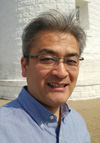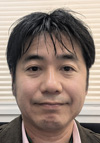
超高齢社会を迎えた我が国において,高度先進医療の更なる充実と発展に対する期待は益々高まっています。同時に基礎生命科学の進展も目覚ましく,それら知見・発見のいち早い臨床応用が期待されています。しかし,医療現場と基礎生命科学研究の間には,以前より「死の谷」と称される知識的・制度的・人的な隔たりがあり,基礎研究成果の効率的な応用や医療知識の基礎生命科学へのフィードバックにとって大きな障害となっています。この状況を踏まえ,基礎生命科学と医療科学の双方に対する深い知識と探求心をもち,生命科学分野・医科学分野及び関連産業分野の発展に貢献する人材の育成が急務となっています。「生命医科学プログラム」では,広島大学の多様な生命科学系教員・医療科学系教員を結集し,医療科学の現場を意識した基礎生命科学教育を行います。これにより,基礎生命科学から医療科学に渡る広範な生物・生命系研究領域の知識と研究実践力を習得し,社会的要請に柔軟に対応できる人材の育成を目指します。

PM2.5や農薬など環境中の化学物質の神経系への影響を調べています。特に発達期影響(胎児期に曝露すると成長後に何が起こるか)や疾患との相互作用(曝露により疾患発症率や重篤度が変わるか)について焦点を当てています。
Our research topics are on the effects of environmental chemicals such as pesticides and PM2.5 on the central nervous system(CNS). We focus on an action of the brain immune cell, microglia. We are also in-terested in the interaction of chemical exposure and CNS disorders like stroke and epilepsy.
keywords:neurotoxicology, environmental chemicals, microglia
- Polycyclic aromatic hydrocarbons in urban particle matter exacerbate movement disorder after ischemic stroke via potentiation of neuroin-flammation. Particle Fibre Toxicol. 20:6(2023)
- Microglial inflammatory reaction regulated by oxidative stress. J Clin Biochem Nutr. 72(1): 23-27(2023)
- A CCR5 antagonist, maraviroc, alleviates neural circuit dysfunction and behavioural disorders induced by prenatal valproate exposure. J Neuroinflam. 19:195(2022)

タンパク質をコードしないRNA(ノンコーディングRNA)を操り、特定の遺伝子活性化を促すメカニズムとその細胞を超えた効果を明らかにすることで、ヒト脳の特徴を理解するための研究を推進している。
Our lab aims to understand the epigenetic mechanisms that underlie human brain development. We em-ploy genome-wide analyses, combined with wide variety of functional analyses. We are now focusing on the involvement of long non-coding RNAs in the gene-specific epigenetic regulation that can shape spe-cies-dependent cellular networking in the cerebral cortex.
keywords:non-coding RNA, epigenome, DNA methylation/demethylation, gene activation, brain, neural stem cell, human,primate, mouse, rodent, species-specific, biodiversity, adaptation, evolution, bioinformatics
- Human-biased TMEM25 expression promotes expansion of neural progenitor cells to alter cortical structure in the developing brain. FEBS Lett 597: 2611(2023)
- Evolutionary acquisition of promoter-associated non-coding RNA(pancRNA)repertoires diversifies species-dependent gene activation mechanisms in mammals. BMC Genomics, 18:285(2017)
- Bidirectional promoters link cAMP signaling with irreversible differentiation through promoter-associated non-coding RNA(pancRNA)ex-pression in PC12 cells. Nucleic Acids Research, 44: 5105(2016)

ショウジョウバエの遺伝学的手法を活用し、①嗅覚が個体行動・免疫・寿命を制御する仕組み、②睡眠と神経シナプスの関係、③栄養環境による組織サイズ調節機構、④ヒト疾患関連因子の生理機能、を研究しています。
We are studying the following topics by using Drosophila genetic methods. How does the sense of smell control individual behavior, immunity, and longevity? How does sleep regulate synaptic function? What is the mechanism of tissue size control by nutrition? How is the topology of membrane protein regulated?
keywords:Drosophila, olfaction, longevity, aging, innate immunity, behavior, sleep, synapse, tissue size, membrane pro-tein topology
- Multiple functions of the ER-resident VAP and its extracellular role in neural development and disease/J Biochem/165/391-400/2019
- Dendritic Eph organizes dendrodendritic segregation in discrete olfactory map formation in Drosophila/Genes Dev/31/1054-1065/2017
- The Strip-Hippo pathway regulates synaptic terminal formation by modulating actin organization at the Drosophila neuromuscular synaps-es/Cell Rep/16/2289-2297/2016

両生類のイモリは極めて強い再生能力を持ち、体の様々な部位を再生できます。私達はイモリ再生能力を支える原理の解明を目指しています。また、研究者にイベリアトゲイモリを提供するバイオリソースを運営しています。
The amphibian newt has the remarkable ability to regenerate various body parts. Our laboratory aims toe-lucidate the mechanisms of organ regeneration using newts as experimental model. We are also workin-gon the development and maintenance of a bioresource of the Iberian ribbed newts.
keywords:newt, regeneration, bioresource
- Amphibian newts as experimental models for studying weight gain after castration/ Endocrine Journal. 71: 181-191(2024)
- A comprehensive reference transcriptome resource for the Iberian ribbed newt Pleurodeles waltl, an emerging model for developmental and regeneration biology/ DNA Res. 217-229(2019)
- Cas9 ribonucleoprotein complex allows direct and rapid analysis of coding and noncoding regions of target genes in Pleurodeles waltl development and regeneration/ Dev. Biol. 127-136(2018)

機能的MRIデータに機械学習(深層学習含む)を適用することにより、脳内で五感の感覚情報が主観的価値に変換される情報処理過程を研究している。複雑な人間行動を情動により説明するモデルの提案を目指している。
I’m conducting research on how sensory information from the five senses is transformed into subjective value in the brain by applying machine learning (including deep learning) to functional MRI data. I aim to propose models that explain complex human behaviors through emotions.
keywords:Functional MRI, Machine learning, Deep learning, Emotion
- Population coding of affect across stimuli, modalities and individuals Nature neuroscience 17(8), 1114-1122(2014)
- Distinct representations of basic taste qualities in human gustatory cortex Nature communications 10(1), 1048(2019)
- Evaluation of the hierarchical correspondence between the human brain and artificial neural networks: A review Biology 12(10), 1330(2023)

染色体末端テロメアの維持機構を中心に、染色体全体の安定な維持機構、DNA修復機構などの解析とそのがん治療への応用を目指している。最近はライブイメージングによる染色体動態の定量解析にも取り組んでいる。
Study about telomere maintenance, chromosome stability, and DNA repair and their application to anti-aging and anti-cancer research. We also take fluorescence live cell imaging and analyze them quantitatively to study the role for dynamics of proteins and chromatin in nuclear function.
keywords:telomere, chromosome stability, DNA repair, anti-aging, anti-cancer, fluorescence live cell imaging, dynamics of proteins, nuclear function
- Spindle pole body movement is affected by glucose and ammonium chloride in fission yeast. Biochem Biophys Res Commun.(2019)
- A diffusion model for the coordination of DNA replication in Schizosaccharomyces pombe. Sci Rep.(2016)
- Chromosome passenger complex is required for the survival of cells with ring chromosomes in fission yeast PLoS One.(2018)

目を持たない線虫がどのように光を感知しているのか、また光環境が線虫の形態形成や行動にどのように影響しているのか、分子メカニズムの解明を目指して研究を行っています。
Although nematodes do not have eyes, worms can detect light and show light avoidance behavior. We try to reveal the molecular and neural mechanisms of how light is detected by the nematode, and how the light environment affects development and behaviors.
keywords:nematode, light, behavior, development, genetics, evolution, phenotypic plasticity, polyphenism
- “cGMP-dependent pathway and a GPCR kinase are required for photoresponse in the nematode Pristionchus pacificus”, PLoS Genetics,20, e1011320(2024)
- “Co-option of an astacin metalloprotease is associated with an evolutionarily novel feeding morphology in a predatory nematode”, Mol Biol Evol, 40, msad266,(2023)
- “Screening for CRISPR/Cas9-induced mutations using a co-injection marker in the nematode Pristionchus pacificus” Development Genes and Evolution, 230, 257–264(2020)

真核細胞の機能を保証する細胞構造の制御メカニズムに関する研究を進めている。具体的には、「核サイズを制御する仕組み」と「細胞の形を制御する仕組み」の分子レベルでの解明を目指している。
We study the control mechanism of intracellular structure that ensures eukaryotic cellular function. Our research is currently focused on nuclear size, establishment and maintenance of cell polarity, and organi-zation of the cytoskeletons such as actin and microtubule. We use fission yeast as a model organism for eukaryotic cells.
keywords:intracellular structure, nuclear size, cell polarity, cytoskeleton, cell growth, organelle size, fission yeast, cell biology
- Nuclear membrane protein Lem2 regulates nuclear size through membrane flow. Nat. Commun.(2019)
- A systematic genomic screen implicates nucleocytoplasmic transport and membrane growth in nuclear size control. Plos Genet.(2017)
- Calcineurin ensures a link between the DNA replication checkpoint and microtubule-dependent polarized growth. Nat. Cell Biol.(2011)

生物集団の行動の原理や、行動を支配する脳神経回路の老化機構の研究を行っています。そのため線虫C. エレガンスをモデル動物にした行動実験と、最先端の光技術を用いた顕微鏡開発や数理モデリングを駆使し、原子から個体集団レベルまでの全階層を対象にした解析を進めています。
Living things exhibit clever information processing to cope with environmental changes at the individual and population levels. I seek physical rules governing individual and population level behaviors and neural circuit aging. For this purpose, I have taken interdisciplinary approaches using neuroscience, ethology, en-gineering and nonlinear physics.
keywords:biophysics, collective behavior, aging, optics
- Regulation of behavioral plasticity by systemic temperature signaling in Caenorhabditis elegans, Nature Neurosci, 2011
- C. elegans collectively forms dynamical networks, Nature Commun, 2019
- High-throughput optical quantification of mechanosensory habituation reveals neurons encoding memory in Caenorhabditis elegans,PNAS, 2014

両生類を用いた発生生物学を基盤としつつ細胞生物学、先端ライブイメージング解析を取り入れることで、神経管をはじめとする上皮性器官の形成機構とその破綻により発症するヒト先天異常に関する研究を進めています。
I am studying embryonic development at the cellular and molecular levels. Using amphibians, I analyze the mechanisms of formation of epithelial organs such as the neural tube and human congenital abnormalities caused by its disruption, utilizing cell biology and advanced live imaging techniques.
keywords:embryonic development, amphibian, Xenopus, epithelial morphogenesis, congenital disabilities, live imaging
- Compromised actin dynamics underlie the orofacial cleft in Baraitser-Winter Cerebrofrontofacial Syndrome with a variant in ACTB. Hum Mol Genet 33:1975-1985(2024)
- Differential cellular stiffness across tissues that contribute to Xenopus neural tube closure. Dev Growth Differ 66:320-328(2024)
- Distinct intracellular Ca2+ dynamics regulate apical constriction and differentially contribute to neural tube closure. Development 144:1307–1316 (2017)

極めて高い再生能力を誇るイモリがもつ、欠損部位を補填するリプログラミング(脱分化)と細胞運命決定が起こるメカニズムを、種々のバイオセンサーを用いて、実時間・実空間で明らかにすることを目指している。
We aim to elucidate the mechanisms of reprogramming(dedifferentiation)and cell fate determination in newts, which have extremely high regenerative capacity to compensate for defective organs. in real time and in real space with a variety of biosensors.
keywords:newt, regeneration, dedifferentiation, reprogramming, cell fate determination
- Single‐molecule tracking of Nanog and Oct4 in living mouse embryonic stem cells uncovers a feedback mechanism of pluripotency main-tenance. EMBO J. e112305(2023)
- Single cell analysis reveals a biophysical aspect of collective cell state transition in embryonic stem cell differentiation. Sci Rep 8:11965(2018).
- The active stem cell specific expression of sponge Musashi homolog EflMsiA suggests its involvement in maintaining the stem cell state.Mech Dev 129(1-4):24-37(2012)

我々のゲノムの中には、「内在性レトロウイルス」と呼ばれるウイルス様配列が潜んでいる。ネコを中心とした哺乳類における内在性レトロウイルスの機能や獲得メカニズムについての研究を行っている。
Part of our genome is composed of sequences with viral origin, namely "endogenous retroviruses( ERVs)".
We are studying the function and acquisition mechanism of ERVs in mammals.
keywords:endogenous retroviruses
- Establishment of CRFK cells for vaccine production by inactivating endogenous retrovirus with TALEN technology/Scentific Reports(2022)
- Multiple invasions of an infectious retrovirus in cat genomes/Scientific Reports(2015)
- Characterization of feline ASCT1 and ASCT2 as RD-114 virus receptor/Journal of General Virology(2013)

環境温度の変動に対する生物の温度適応メカニズムを分子レベルで研究し、季節適応機構の理解を目指しています。アプローチの手段として、タンパク質分子(プロテインキナーゼや転写因子)の生化学的な解析を行っています。
To understand seasonal adaptations in living organisms, we are studying the molecular mechanisns of temperature adaptation. For this purpose, we are performing biochemical analysis of proteins including protein kinases and transcription factors.
keywords:environmental temperature, biochemistry, cellular physiology, protein kinase, circadian clock
- Candidate plasticity gene 16 and jun dimerization protein 2 are involved in the suppression of insulin gene expression in rat pancreatic INS-1 β-cells. Mol. Cell. Endocrinol. 527: 111240(2021)
- Candidate plasticity gene 16 mediates suppression of insulin gene expression in rat insulinoma INS-1 cells under glucotoxic conditions.Biochem. Biophys. Res. Commun. 512: 2 189-195(2019)
- Na+/Ca2+ exchanger mediates cold Ca2+ signaling conserved for temperature-compensated circadian rhythms. Sci. Adv. 7: 18 eabe8132(2021)

ゲノム編集技術を用いた疾患のモデルマウスの作製と表現型解析を行っています。将来的にはヒト疾患の病態解明や創薬研究に繋げたいと考えています。
Point mutations in human genome induce genetic disorders. To understand the mechanism of human dis-orders, disease model animals are useful tools. My purpose is the establishment of human disease model mice by CRISPR/Cas9 based genome editing technology and analysis of model mice to reveal pathology of human disorders.
keywords:genome editing, human mutation, genetic disorder
- Insufficiency of ciliary cholesterol in hereditary Zellweger syndrome/EMBO J 39:e103499/2020
- PLK1-mediated phosphorylation of WDR62/MCPH2 ensures proper mitotic spindle orientation/Hum Mol Genet 26:4429-4440/2017
- Phosphorylation of myosin II regulatory light chain by ZIP kinase is responsible for cleavage furrow ingression during cell division in mam-malian cultured cells/Biochem Biophys Res Commun 459:686-91/2015

組織内の光照射領域だけのオミクス情報を取得できる技術、光単離化学(PIC)の開発に取り組んでいます。また、PICを活用し、脳の発生・発達や老化過程で生じる神経系疾患の発症機構の解明も進めています。
I’m working on developing a technology called Photo-isolation Chemistry(PIC), which enables the isolate omics data from UV-irradiated areas within a tissue section. Concurrently, I’m studying to elucidate the mechanisms underlying the onset of neurological disorders during brain during brain development and ag-ing by using PIC.
keywords:spatial omics, photo-isolation chemistry(PIC), brain development, aging process, neurological disorder, epi-genetics
- Photo-isolation chemistry for high-resolution and deep spatial transcriptome with mouse tissue sections. STAR Protoc. 3:2 101346(2022)
- .High-depth spatial transcriptome analysis by photo-isolation chemistry. Nat. Commun. 12-4416(2021)
- PRMT1 regulates astrocytic differentiation of embryonic neural stem/precursor cells. J. Neurochem.142:6 901-90(2017)

真核生物のゲノム安定性維持に必要な分裂期制御、特に紡錘体微小管の形成機構に注目し、モデル生物である酵母を用いて研究を行っている。また、得られた知見を応用して、ヒト疾患治療薬の開発にも取り組んでいる。
Our main research interests are the molecular mechanisms of mitotic progression, particularly the spindle assembly which is required for proper chromosome segregation. For this purpose, we usually use yeast as a model organism. We also aim to apply our findings towards the development of novel anti-cancer drugs.
keywords:mitosis, chromosome segregation, spindle assembly, microtubule, actin, kinesin, myosin, yeast, anti-cancer drug
- Escape from mitotic catastrophe by actin-dependent nuclear displacement in fission yeast. iScience, 24:102031.(2021)
- How Essential Kinesin-5 Becomes Non-Essential in Fission Yeast: Force Balance and Microtubule Dynamics Matter. Cells, 9:1154.(2020)
- Kinesin-6 Klp9 plays motor-dependent and -independent roles in collaboration with Kinesin-5 Cut7 and the microtubule crosslinker Ase1 in fission yeast. Sci Rep, 9:7336.(2019)

機能的MRIと深層学習を用いて、脳の感覚処理をモデル化することに研究している。特に触覚に着目し、複雑な感覚情報がどうのように統合されて知覚を形成するのかを解明することを目指している。
My research focuses on modeling the brain sensory processing using artificial neural networks and func-tion MRI. I aim to understand how the complex sensory information integrates to form the human percep-tion (specific focus on haptic perception).
keywords:Functional MRI, Machine Learning, Deep learning, Haptics
- Effect of 3D Microstructure of dermal papillae on SED Concentration at a Mechanoreceptor Location. PLOS ONE 12(12), e0189293(2017)
- Distillation of Regional Activity Reveals Hidden Content of Neural Information in Visual Processing. Front in Hum Neurosci 15:777464(2021)
- Evaluation of the hierarchical correspondence between the human brain and artificial neural networks: A review. Biology 12(10), 1330(2023)

私の研究は、多階層オミクス解析と機能実験を組み合わせて、細胞外エクソソーム経路がどのように神経発生を調節するかを解明し、最終的には脳進化における新皮質の拡大と脳回形成においてエクソソームが果たす根本的な役割を明らかにすることを目的としています。
My research aims to investigate how extracellular exosomal pathways coordinate neurogenesis through multi-omics analysis and functional assays, ultimately elucidating the fundamental role of exosomes in driving neocortical expansion and gyrification during brain evolution.
keywords:brain, exosome, evolution
- Human-biased TMEM25 expression promotes expansion of neural progenitor cells to alter cortical structure in the developing brain. FEBSlett. 597(21), 2597-2699(2023)
- Taxonomy of Naumann’s and dusky, red-throated and black-throated thrush complexes(Aves: Turdidae)using morphological and molec-ular characteristics. Anim.Biol. 74(2), 213-236(2024)

匂いセンサーである嗅覚受容体は、意外にもさまざまな臓器に発現しています。こうした"非嗅覚組織"における嗅覚受容体の機能について、モデル生物であるショウジョウバエを用いて解析しています。
Olfactory receptors, sensors for odorants, are also expressed in various non-olfactory tissues. We are studying the function of olfactory receptors in non-olfactory tissues by using Drosophila melanogaster.
keywords:Drosophila, olfaction, olfactory receptor, non-olfactory tissues
- Generation of Odorant Receptor-QF2 Knock-In Drivers for Improved Analysis of Olfactory Circuits in Drosophila. 30(4):e70028 (2025).

新規先端光学計測技術を開発し、それらを用いて幹細胞に対する放射線被ばく影響に関連する生物学研究に取り組む。研究成果の実用化・産業化にも積極的に取り組んでおり、幅広く融合的/学際的研究を実践している。
We conduct biological research related to the effect of radiation doses on stem cells using new state-of-the-art optical measurement techniques developed by ourselves. We are also actively involved in the prac -tical application and industrialization of our own research results, and practice a wide range of interdisci-plinary research.
keywords:radiation-dose effect, stem cell research, quantitative biology, optical microscopy, spectroscopy, machine learning
- Following embryonic stem cells, their differentiated progeny, and cell-state changes during iPS reprogramming by Raman spectroscopy.Anal Chem 92, 14915–14923(2020)
- Linking substrate and nucleus via actin cytoskeleton in pluripotency maintenance of mouse embryonic stem cells. Stem Cell Res. 41,101614(2019)
- Second harmonic generation polarization microscopy as a tool for protein structure analysis. Biophys Physicobiol. 16, 147-157(2019)

 Home
Home



